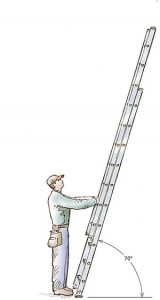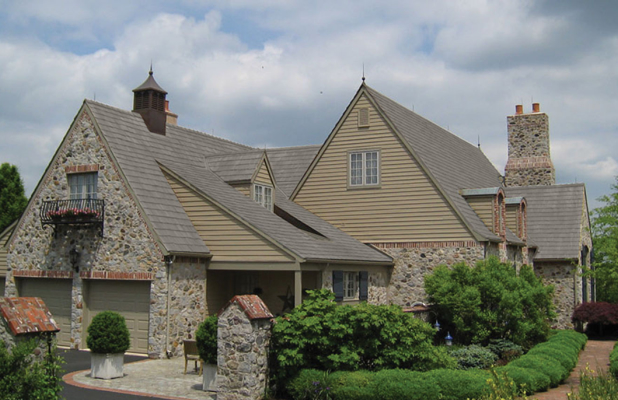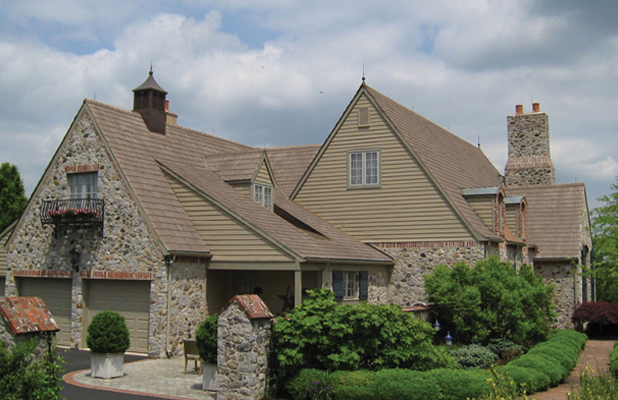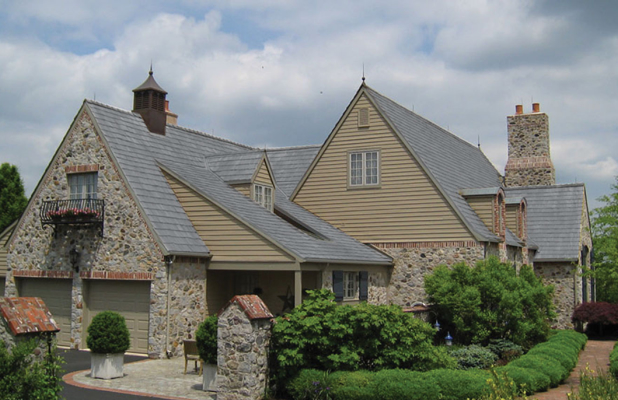Cedar shakes and shingles are uniquely able to handle high wind-speed, impact and moisture but recent hurricane rains have made many cedar roof homeowners aware of a commonly overlooked feature of their roof – the gutters.
Soon the leaves will be falling and that will only make matters worse so now is the time to get your mind IN the gutter and think about preventative maintenance.
Clean your Gutters Before Problems Start
A gutter system in good working order is the last and best defense against water getting into the house. Plugged, faulty, or missing gutters allow water to damage roofing, exterior and interior walls, and floors, and may even undermine foundations. Old House Online has published some great advice in their Gutter Clinic to help keep your gutters clean and prevent damage this season.
From Gutter to Downspout
Installed along the roofline and eaves of a house, a gutter collects water that runs off the roof during rain storms and channels it toward downspout, usually installed at the corners of the house. Gutters are usually installed on a slight slope that encourages the water to flow toward the downspouts. The downspouts direct the water to the ground level, where downspout extensions carry it away from the house. These extensions should discharge water at least 10′ away from the foundation, or into subsurface drainage systems. Never discharge water onto sidewalks and driveways, where it can freeze and create a slipping hazard.
The most common gutter profiles are Half-Round and K-Style. Half-round gutters are found on many historic homes, often hand-crafted in copper while K-style are usually machine-made. Featuring a molded face, this style is more common on newer homes.
Historic Home Gutters
According to an article posted by Period Homes, Style and Function: Traditional Gutters, manufactured metal gutters started to appear in the latter-19th century and the longest running type is the iconic half-round gutter. Widely advertised by 1870, the half-round gutter quickly became popular because of its effectiveness in catching and draining roof run-off, as well as its ready adaptability to installation on different buildings and roof eave configurations.
This long history and versatility makes the half-round gutter a suitable default choice for many historic houses that, while they may never have had half-round gutters – or any gutters – possibly could have had them. Since the 1950s, the K-style or ogee-style gutter has become the dominant manufactured type, due in part to its ease of installation to eave fascia and colonial cornice appearance, but it too has a decades-long history.
While gutters and downspouts are necessary items. They can also be beautiful finishing touches. The Cedar Roof Company offer a choice of custom colors in aluminum, as well as classic copper as Finishing Touches to your cedar roof installation. There are also a number of manufacturers who can assist in the replication of custom gutters and drainage accessories such as ornamental rain boxes for older homes and unique roof profiles. There are even artists who produce custom rain-chains and decorative spouts.
Whether you have aluminum K-style or copper half-round gutters, seasonal cleaning and regular maintenance are the keys to keeping water from getting into your house.
Gutter Cleaning & Maintenance
Old House Online suggests cleaning your gutters at least twice a year: before cold weather arrives in the fall, and after the snow and ice have melted in spring. Accumulations of dirt, leaves, and other debris not only reduce the water-carrying capacity of the gutter, but also trap moisture. The moist environment is an ideal breeding ground for mosquitos and will certainly lead to corrosion (not to mention seedlings and vines that can lead to more damage) if not kept in check.
To inspect gutters, use a stout extension ladder, ideally one fitted with a standoff bar that holds the ladder several inches away from the building. Gutters are only strong enough to hold water, so avoid laying the ladder directly against the gutter run.
Practice Ladder Safety on the Roof
Every year there are about 160,000 ladder injuries, 300 of which are fatal. That’s nearly three times the number of tablesaw accidents and has shown a 50% increase in a 15-year time period. It’s not that ladders are complicated to operate; Ladders are dangerous because their simplicity makes people overconfident, and overconfidence can quickly lead to carelessness. If you plan to clean your own gutters, take the time to read this article from Fine Homebuilding, Using Extension Ladders Safely which outlines The American Ladder Institute’s (ALI) guidelines to setting up and using an extension ladder safely or visit www.laddersafety.org.
How to Clean Gutters
To clean, wear rubber gloves and use your hands or a small rake or scoop out the mess. While you’re cleaning, inspect the gutter for leaks, rust or rot, failing joints, and missing or loose support brackets. Badly rusted or corroded gutter runs should be replaced, as should missing brackets. Then check the downspouts and all its components for damage.
Once the gutter is clean and any minor repairs to the components are made, run some water into the gutter. It should run directly toward the lowest point on the run, the downspout. If water pools or runs in a different direction, adjust the hangers until the slope directs the water in the proper direction.
Then again, you can spare all that trouble and have Rhino Gutter Guard installed by The Cedar Roof Company as one of the Finishing Touches on your roof installation. This system uses a Stainless Steel Micro-Mesh which covers a solid aluminum substrate to prevent debris from ever entering your gutter. A uniquely textured “Rhino Skin” prevents anything from sticking to it and a sturdy profile strengthens the entire gutter system for greater durability and longevity.








